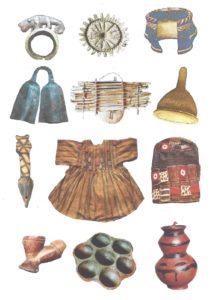
Comments on the Plate “Some Objects of Material Culture”
From top left to bottom right:
Bunoruk nifelin (finger ring with a chameleon)
The depicted ring was produced by the Sandema-Choabisa blacksmiths (Abakper’s sons) in 1994. The chameleon may provide a connection to an earthen jadok-shrine within the compound. Today the ring has become a favourite souvenir for visitors and tourists.
Nanggook (morning star, amulet)
The amulet disc, depicting the morning star (Venus) with 23 spikes and 14 radial relief lines and a centred knob (height of the knob = 1 cm) was produced in Sandema-Choabisa by Abakper’s sons in 1984. They applied the cire-perdu technique. Amulets like this one may exhibit the character of a jadok shrine. (A jadok is a spirit that is sacrificed to.) In Wiaga and other villages, the blacksmiths cut nanggook amulets out of iron sheets.
Nakogla anklet (name could not be explained)
The biconical anklet was acquired in Sandema Kalijiisa in 1994. There’s a good chance it was not produced in the Bulsa area since anklets and bangles were used as means of payment in large parts of West Africa. In olden times it was only worn by rich women on both ankles, but they are no longer worn today, although many old people keep them in their ancestor’s room (dalong).
Sinleng (an iron double bell; sinlengsa is plural)
Such a bell, in a suspended position, is struck from outside with a hard piece of wood or an animal horn. It is struck, for example, when a chief or sub-chief (kambonnaab) is going to speak or during the sinlengsa-dance at the second funeral celebration.
It can be played together with drums but never with flutes, e.g. for war dances and other funeral music. If there is no sinleng in a compound, a glass bottle can be struck for an important ritual.
Ngmiena baganing (raft zither made of ngmiena which are split millet stalks)
This instrument has become very rare today. It accompanies songs without any other instrument, though it is sometimes played with another baganing. The straw “strings” are either plucked with fingers or beaten with a small stick (in this case it is merely a rhythmical instrument).
Sinyaara (basketry rattle)
The rattle is made from kpingkpa-nyigi or other split grass species.
Juik / wiik (notched flute, also called whistles by Bulsa)
Flutes are made by specialists from the wood of the taaruk (Mitragynis inermis) or the kpasagi-tree (Pseudocedrala kotchyi?). The inner cavity is burnt out by the craftsman.
Usually flutes are played in an ensemble: wii-diak (smallest type), wii-sarik or wii-chogsum (middle-sized flute), wii-nubi (biggest type). One flute starts playing, and then the others follow. Flutes can be used (e.g. by shepherds) for transmitting simple message, but usually the small tagalik flute is used for this.
Saba-garuk (smock with saba-amulets)
A smock which was originally blue and white was dyed brown for camouflage in order to use it as a hunting dress.
Each leather pocket (saba) containing a particular medicine (tiim) should protect the wearer from a particular danger. Smocks like this are common in large parts of West Africa.
Saba-zutok (cap with saba-amulets)
26 saba-amulets were applied to a cap made of blue cloth. The depicted cap was acquired from an old man in Sandema Kalijiisa who thought that this cap had lost its power.
Tacheng (clay head of a smoking pipe)
While all other clay objects are produced by women, the clay heads of these pipes are formed by old men and painted with red daluk-clay. The men then ask a female potter for permission to burn the pipe in her bonfire.
Maasa-cheng (frying pan or patty-pan for frying millet cakes) Frying pan with 7 hollows (chengsa) which are filled with shea butter and liquid dough made of millet flour and water before it is put on an open fire to fry millet cakes (maasa). One maasa-cheng may have 4-12 hollows.
Li-toma (clay vessel with two bellies)
This type of vessel is mainly made in Fumbisi. Although they are known in other parts of West Africa, they are rather rare among the Bulsa. They are particularly used for storing beans (tue) and buura-seeds.
- Coverpage
- Editors, Notes for Contributors and Copyright
- Editorial
- Events (Franz Kröger, Robert Asekabta, Cornelius Adumpo, John Agandin et.al.)
- Maaka Projects in Gbedema 2017-2018 (Christine Arnheim)
- My Journey to France (Robert Asekabta)
- The 2018 Mid-Year Performance Review – Bulsa North District
- Discussions in the Facebook Group “BULUK KANIAK”
- Who on Earth is Interested in the Bulsa? (Franz Kröger)
- Cultural Heritage and the Possibilities of Tourism (Franz Kröger)
- Feok Festival 2017 Review (Augustine A. Atano)
- The Bulsa Feok — Accra Chapter (John Agandin)
- Two Poems: A Tale of Footprints and The Baobab (John Agandin)
- Some Objects of Bulsa Material Culture
- Bulsa Districts (Map)
- Back cover of the printed edition